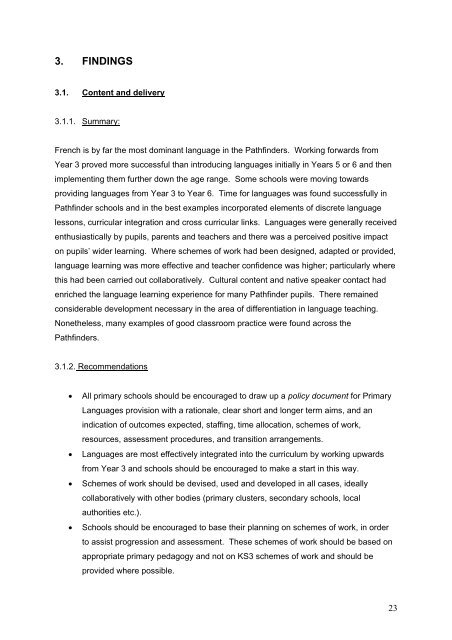Evaluation of the Key Stage 2 Language Learning Pathfinders
Evaluation of the Key Stage 2 Language Learning Pathfinders
Evaluation of the Key Stage 2 Language Learning Pathfinders
You also want an ePaper? Increase the reach of your titles
YUMPU automatically turns print PDFs into web optimized ePapers that Google loves.
3. FINDINGS3.1. Content and delivery3.1.1. Summary:French is by far <strong>the</strong> most dominant language in <strong>the</strong> <strong>Pathfinders</strong>. Working forwards fromYear 3 proved more successful than introducing languages initially in Years 5 or 6 and <strong>the</strong>nimplementing <strong>the</strong>m fur<strong>the</strong>r down <strong>the</strong> age range. Some schools were moving towardsproviding languages from Year 3 to Year 6. Time for languages was found successfully inPathfinder schools and in <strong>the</strong> best examples incorporated elements <strong>of</strong> discrete languagelessons, curricular integration and cross curricular links. <strong>Language</strong>s were generally receivedenthusiastically by pupils, parents and teachers and <strong>the</strong>re was a perceived positive impacton pupils’ wider learning. Where schemes <strong>of</strong> work had been designed, adapted or provided,language learning was more effective and teacher confidence was higher; particularly wherethis had been carried out collaboratively. Cultural content and native speaker contact hadenriched <strong>the</strong> language learning experience for many Pathfinder pupils. There remainedconsiderable development necessary in <strong>the</strong> area <strong>of</strong> differentiation in language teaching.None<strong>the</strong>less, many examples <strong>of</strong> good classroom practice were found across <strong>the</strong><strong>Pathfinders</strong>.3.1.2. Recommendations• All primary schools should be encouraged to draw up a policy document for Primary<strong>Language</strong>s provision with a rationale, clear short and longer term aims, and anindication <strong>of</strong> outcomes expected, staffing, time allocation, schemes <strong>of</strong> work,resources, assessment procedures, and transition arrangements.• <strong>Language</strong>s are most effectively integrated into <strong>the</strong> curriculum by working upwardsfrom Year 3 and schools should be encouraged to make a start in this way.• Schemes <strong>of</strong> work should be devised, used and developed in all cases, ideallycollaboratively with o<strong>the</strong>r bodies (primary clusters, secondary schools, localauthorities etc.).• Schools should be encouraged to base <strong>the</strong>ir planning on schemes <strong>of</strong> work, in orderto assist progression and assessment. These schemes <strong>of</strong> work should be based onappropriate primary pedagogy and not on KS3 schemes <strong>of</strong> work and should beprovided where possible.23

















